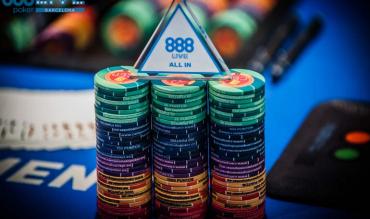Poker isn’t as chaotic as some professional-level sports games. It’s NOT a free-for-all/mad scramble with players all playing simultaneously and trying to score (place bets) at the same time.
Instead, there’s a more systematic approach (similar to chess) –
- Betting involves knowing who is first to act each round
- The action moves sequentially from player to player
- Arguably the most crucial aspect is knowing which actions one can take and when
The scope of this article is to elaborate on this latter part – the various betting actions in poker. We’ll expand on the following topics –
What are poker actions?
How do you play each of them?
What some general strategy is for each.
The list of actions that we’ll expand upon are -
Poker Action #1: CHECK
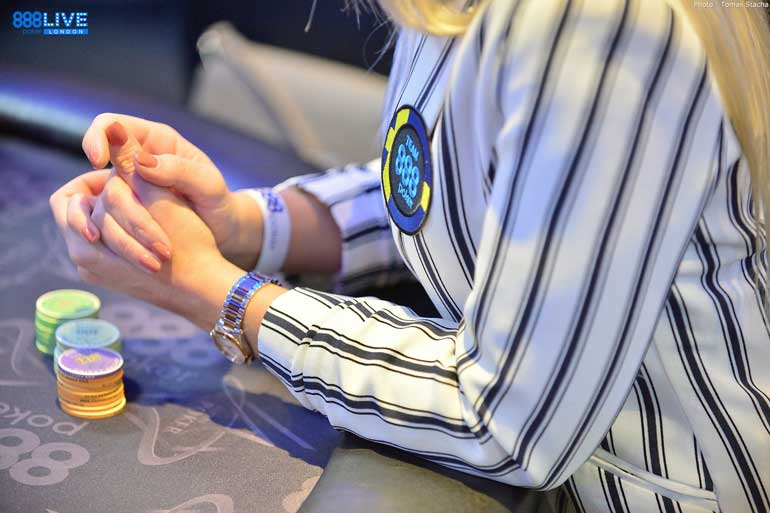 Poker Action: CHECK
Poker Action: CHECK
A check is a passive action at the poker table. It’s pretty much the same as placing forward a bet of $0. When you check, no money enters the pot, and the betting action passes to the next player.
Note that a check is only allowable at the start of the betting round. You may also check and/or when all players before you have checked as well. Once a bet is placed forward, checking is no longer allowable for the rest of that betting round. (Subsequent betting rounds can still start with checks.)
Some players will verbally say “check” in live play to signify this action. But many will use a silent gesture by tapping the table. You can silently check in the following ways –
- Use a closed fist (like knocking on a door)
- With an extended hand
- With one or two outstretched fingers
- By holding a chip stack and raising up and down – vertically
- Even by dropping one arm on top of the other if they are crossed in front of you
Checking Strategy
There will always be exceptions to the rules/guidelines. But you should frequently look to check in the following situations:
- When you don’t have the betting lead from the previous betting round, it’s usually a good idea to “check to the raiser”. This player will frequently have a nut and range advantage on most boards.
- Say you have the preflop betting lead and are out of position post-flop. You should look to check a lot more frequently than if you were in position with the preflop betting lead
- When you’re involved In multi-way pots: the more players there are, the more frequently you should generally look to check.
- When the middle (or bottom) card pairs on the turn when you had the preflop betting lead and c-bet the flop
There’s always the possibility (and decent likelihood) that another player will bet when you check. So, it’s essential to decide in advance what action you’ll be taking after checking:
- Check-Folding: Do this with your trash and weakest hands that don’t have much equity or room to improve.
- Check-Calling: Do this with your medium-strength hands and occasionally with some monsters (to slowplay for deception and balance). Some of your draws can also fall into this category. But make sure you have the correct odds or implied odds to continue.
- Check-Raising: Do this with your strongest hands (especially when they’re vulnerable to action-killing turn/river cards). You can also choose the poker action with some of your draws to balance out this part of your range.
| CHECKING SUMMARY: Generally, you should CHECK when you don’t have the betting lead from the previous round or when you have a marginal hand. Be sure you know in advance what your next action will be (fold, call, or raise) if you check and someone else bets. |
Poker Action #2: BET
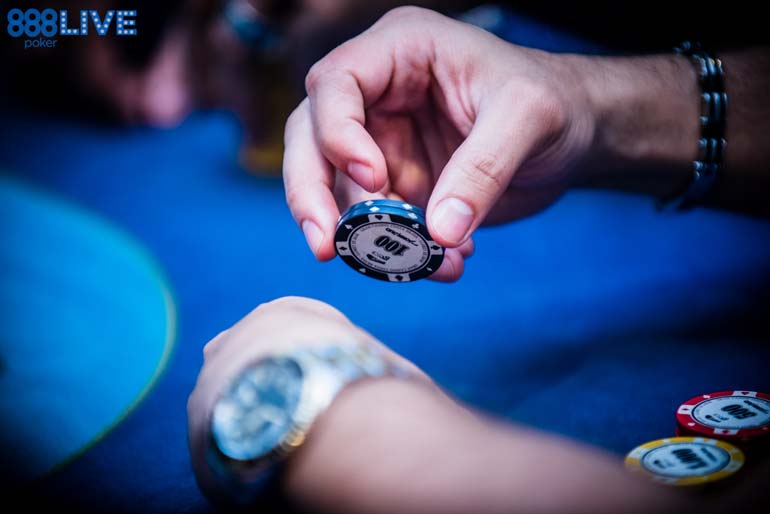 Poker Action #2: BET
Poker Action #2: BET
A bet is an aggressive action at the poker table. Aggression helps you win in poker. It gives you another way to win the hand than just at showdown. Your opponents could all fold to your bet, and you could win the pot without showing your cards!
Your bet sizes should account for the size of the pot – NOT solely the strength of your hand!
- Use smaller amounts to value bet a broader range and bluff more infrequently.
- Use larger bets to value bet a narrow, super-strong range and bluff more frequently.
In multi-way pots, smaller bets are generally advisable for earlier betting rounds (i.e., on the flop). Bet larger in the later betting rounds when there are fewer remaining players.
In live play, betting action is in the following two ways –
- Announce the amount verbally beforehand (and then slide your chips systematically into the middle)
- Silently place your betting chips out in one continuous forward motion.
(Be sure not to string bet or angle shoot with your forward motion when you bet.)
Betting Strategy
- Value betting is an acceptable action when you think you’ll be called by worse hands more than 50% of the time.
- Say you’re betting in poker as a bluff. The frequency you need your opponent to fold (and for you to be profitable) depends on the size of the bet.
- To remain challenging to play against, use a consistent bet sizing between your thin value bets and your strong hands. Use the same sizing between your value bets and bluffs.
- Sometimes, it can be okay to split your range into multiple bet sizes. Usually, especially for beginners, it’s better to stick with one consistent bet size for an action. But you may still have to account for the following –
- Board texture
- Whether in position or out of position
- Number of players in the hand, etc.)
Again, make sure that your bet size is consistent with your betting purpose:
- Large bets = strong value hands and more bluff combos
- Small bets = a wider range of value hands and fewer bluffs overall
Understand that board texture can also change drastically from flop to turn to river. If you bet on the flop, don’t feel obligated to continue betting on the turn.
If it’s a less-than-favourable card turns, be prepared to check or check/fold.
| BETTING SUMMARY: Bet your strongest hands for value that can get called by worse holdings. Bet on the flop and turn as a bluff with good semi-bluff combos. (These are hands that can improve to straights or flushes.) Bet the river with your hands that have the weakest showdown value. |
Poker Action #3: RAISE
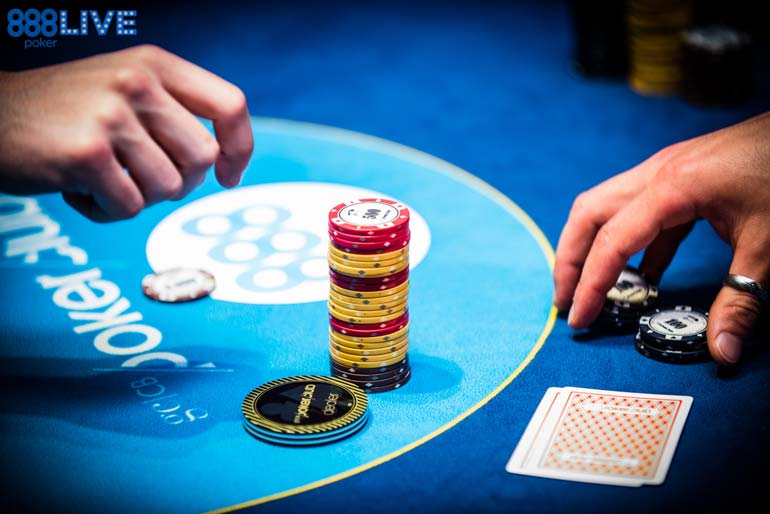 Poker Action: Raise
Poker Action: Raise
A raise is an increase above the current betting amount. Players would need to match the bet to continue in the hand.
- Preflop, the big blind is the initial “bet”.
- The first increase to the betting amount is a “raise”.
- Postflop, a “bet” is a must before any raise can take place.
Note that a legal raise must be at least twice the initial bet amount.
For example, if someone bets $10, the minimum raise size would be $20 total.
Raising Strategy
Raising should always be done preflop if you’re the first to enter the pot (everyone else has folded before you).
(If you want to read why limping – just calling the big blind – is a bad idea, check out this article.)
- Postflop, raising will most commonly be done in the form of a check-raise by an out-of-position player. Why? To make up for their positional disadvantage in a hand.
- They need to use tools such as check-raises to maximise their winnings out of position.
For a good read on how to maximise your EV with check-raises, check out this strategy article.
- When you’re in position postflop, raising will make sense (especially on the flop) when you and your opponent are both deep-stacked.
- You’ll want to start building a pot even more to be able to try and get all-in by the river.
Raising should be generally done with your strongest hands, along with a select few draws. These are the type of hands that can’t afford to just call a bet. Say all you have is a draw but no showdown value.
In terms of the sizing and frequency you choose for a raise, it comes down to a few contributing factors:
- If your opponent bets small, you can check-raise a wider range of hands and for a larger size.
- If your opponent bets large, you should check-raise a narrower range of hands for a smaller size.
- If you’re in position and looking to raise, your overall raise sizes can be slightly smaller than if out of position. You have a positional advantage and would be last-to-act in future betting rounds.
| RAISING SUMMARY: When you’re the first player to enter a pot preflop, always come in with a raise if you’re going to play your hand. For post-flop play, develop a solid check-raising strategy to make up for being out of position (e.g., when in the big blind). |
Poker Action #4: RE-RAISE/3BET+
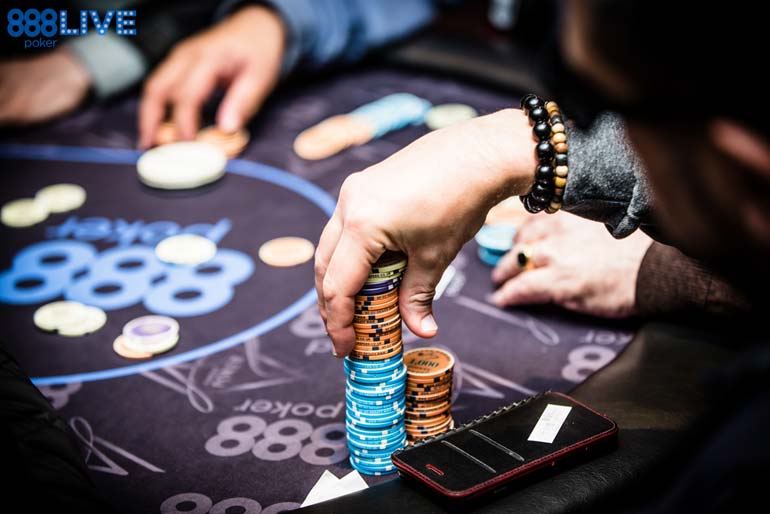 Poker Action: Re-Raise/3bet+
Poker Action: Re-Raise/3bet+
- Preflop, a re-raise (or 3bet) would come immediately after the initial raise.
- Post-flop, you would need to have both a bet and a raise before a re-raise/3bet could occur.
In terms of permitted sizing, a 3bet must at least increase the total bet by the same amount between the original bet and raise.
- For a preflop example, the big blind is 1bb. Say someone makes an initial raise to 3bb. The minimum re-raise/3bet sizing would be 5bb.
- For 4bets+, you must increase the betting amount by, at least, the difference between the last two raises/re-raises.
Re-Raising Strategy
- For preflop play, you should generally look to 3bet or fold after an initial raise if you’re going to play your hand. (It’s usually okay to call with some suited broadway cards and pairs that are too weak to 3bet.)
- In position, you should take a polarised 3-betting strategy –
- Re-raising your strongest pairs and best suited Aces for value
- Bluffing hands like baby suited Aces (A2s-A5s), perhaps AQo or AJo, some suited connectors and even some suited one-gappers.
- From the small blind, especially against later position raises, you’re going to want to 3bet a more linear approach. You should, either 3bet or fold with not much calling at all.
- For postflop play, 3betting with a high frequency isn’t usually an “optimal” betting strategy on most boards. For example, say you have KK on K72 and someone check-raises. You don’t want to 3bet - especially with a positional advantage.
- You’re going to get all-in anyway against other sets. By just calling, you give your opponent a chance to keep bluffing and/or improve to a stronger second-best hand. 3betting is usually only good (exploitable) if you think your opponent will call.
| RE-RAISING SUMMARY: Be very selective with what hands you ultimately want to re-raise. Any re-raise will undoubtedly start to grow the size of the pot. Any mistakes you make could be detrimental. For preflop play, familiarise yourself with solid 3bet ranges. |
Poker Action #5: ALL-IN
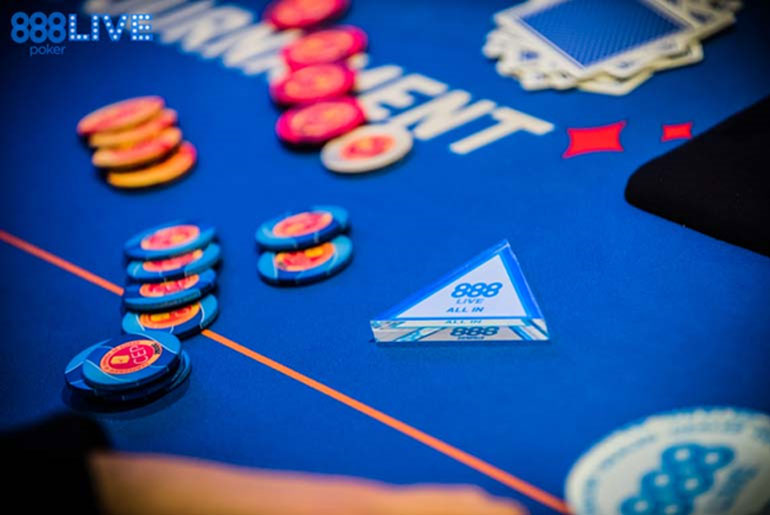 Poker Action: ALL-IN
Poker Action: ALL-IN
Going all-in is a subcategory of all the “bets” mentioned previously in this article –
- Betting
- Raising
- Re-raising
When a player is all-in, they can make no more bets. They are guaranteed to reach a showdown if at least one other player calls. They also stand a chance to win the pot uncontested if the remaining players all fold.
- Any additional betting done by remaining players in a hand (after a player goes all-in) creates a “side pot”.
- The all-in player can only win the main pot.
- The other remaining players (with starting stacks deeper than the all-in player) can continue to battle it out for the side pot.
All-in Strategy
- The same principles apply to this section as outlined in the previous betting sections.
- You can generally bet all-in if you have anywhere between 0.5 to 2x the size of the pot left in your stack.
- You can usually raise all-in if you have about
- When the stack sizes are correct, you should go all-in in the following scenarios –
- Hands with your strongest hands (especially those that need protection)
- Hands with select draw candidates that have strong equity
Specifically for tournaments, going all-in will be the ultimate turning point for you. If you go all-in and lose, your tournament life is over!
| ALL-IN SUMMARY: You should always pay attention to your remaining stack size when betting and/or raising. If you ever get to a point where betting, calling, or raising would leave you with all-in sizing. |
Poker Action #6: CALLING
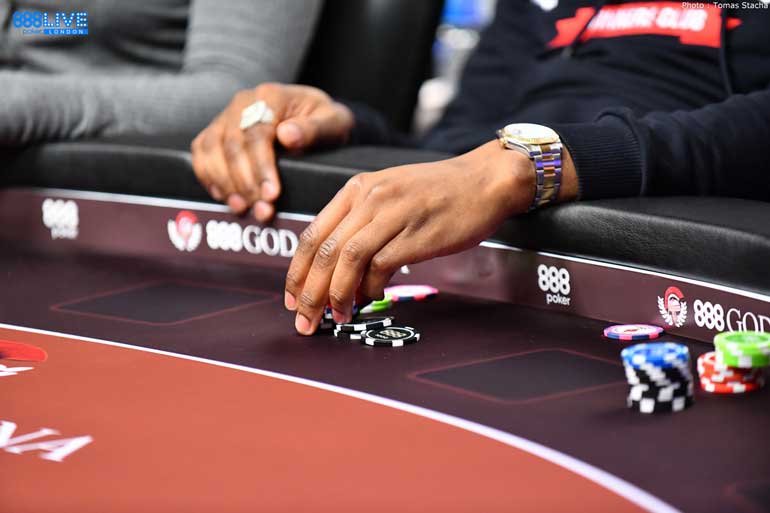 Poker Action: CALLING
Poker Action: CALLING
Calling is the action of matching the amount of a bet or raise made by another player.
- In live play, placing one singular chip into the middle can be a call.
- This play happens most commonly on the river. It saves the caller the time of counting out the specific number of calling chips.
- If they lose, they’ll have to count out the correct number of calling chips.
Calling Strategy
Calling should be the action you opt to take in the following situation –
- When you have a medium-strength hand that is too weak to raise and too strong to fold.
Generally, the number of hands you call (or continue with) should be relative to your opponent’s bet sizing.
For more information on this concept of minimum defence frequency, check out this link.
Your calling hands should be one of the following –
- Able to beat the bluffs of your opponents.
- Some of the hands your opponents may choose to value bet.
| CALLING SUMMARY: Call with hands you think could beat your opponent’s when they bet but aren’t strong enough to raise. It’s essential to note the bet or raise size you’re facing when deciding whether or not to call. In theory, the smaller the bet/raise is, the more hands you should be calling. |
Poker Action #7: FOLDING
 Poker Action #7: FOLDING
Poker Action #7: FOLDING
Folding your cards doesn’t mean bending them in half! It refers to discarding your hand into the middle (generally towards the dealer). You’re relinquishing the ability to win the current pot and continue in the hand any longer.
- It’s generally considered proper etiquette to fold promptly.
- The only time you may want to perhaps “save face” a bit is after you bet and get raised.
- If you fold immediately, people will know you were bluffing. You might want to preserve your image a bit.
Be sure to discard your cards face-down when you fold. An accidentally flipped-up/exposed card could affect the current hand for the remaining players.
Folding Strategy
You’re going to want to fold the following hands –
- Your weakest trash hands versus a bet.
- Your weakest made hands that can’t stand the pressure of large bets now.
- Hands that can’t withstand betting on future streets (especially if you’re out of position).
- Folding can also be acceptable for draws if you don’t have the correct odds (direct or implied) to call.
That said, usually, when creating a betting strategy, you should consider the following –
- When thinking about how you want to flesh out your hand range into the various betting actions –
- Have your raises for value first
- Then your calls
- Just BEFORE the hands, you’d otherwise fold, you’ll usually have a select few combos of bluff raises. These are the hands that are too weak to call but too strong to fold. Bluffing with these combos will help round out how difficult you are to combat.
| FOLDING SUMMARY: Most of your profits in poker will come from hero folding – not from hero calling! Most players play a version of poker that is too value-heavy. So, folding will be what usually saves you money in the long run versus making thin calls. |
The Bottom Line: Summary
Be sure to familiarise yourself with all the betting options available in a poker game –
- Checking
- Betting
- Raising
- Re-raising/3betting
- Going all-in
- Calling
- Folding
Hopefully, this article will have helped you get your feet wet so that you can stay afloat at the tables.
